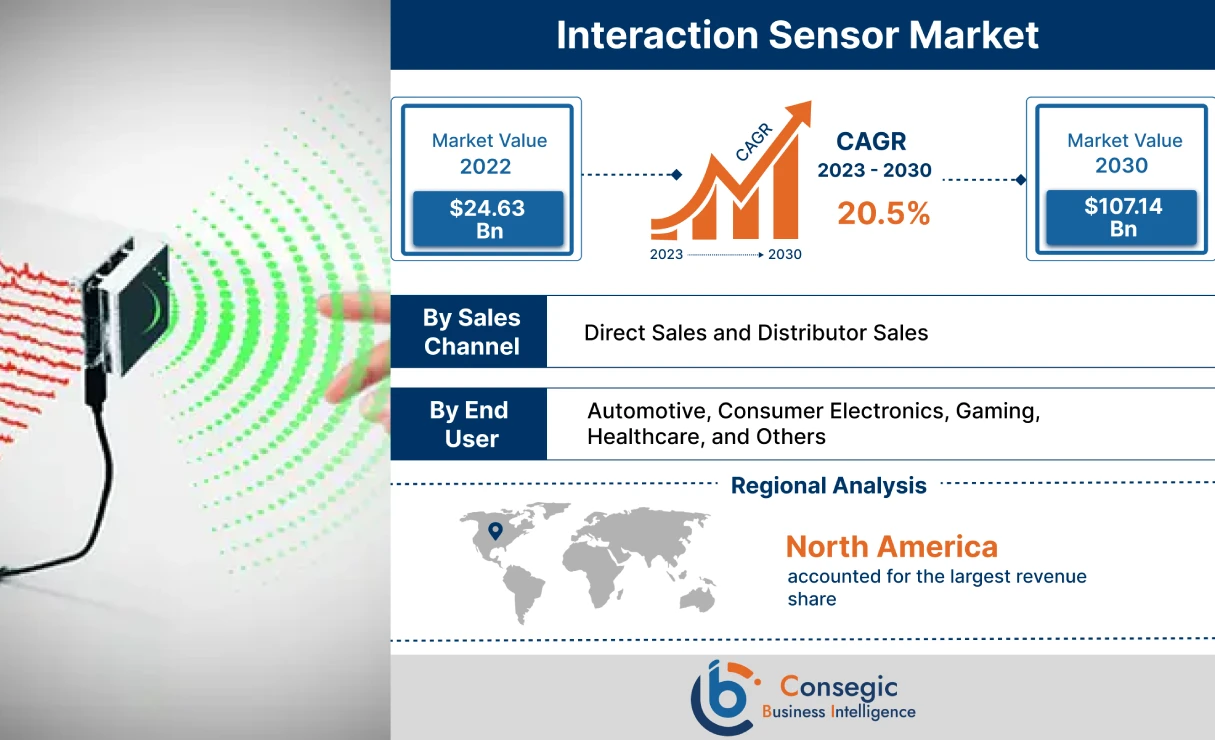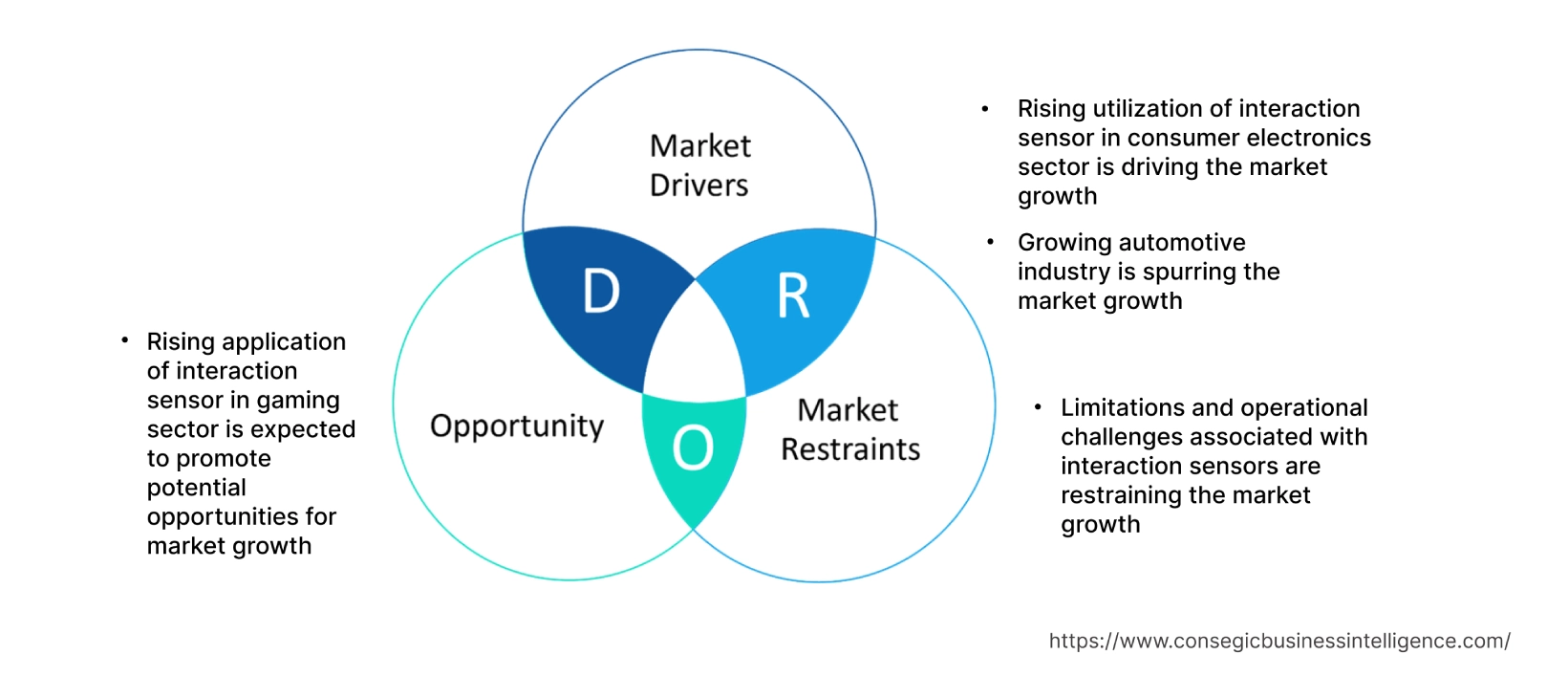- Summary
- Table Of Content
- Methodology
Interaction Sensor Market Size :
Interaction Sensor Market size is estimated to reach over USD 107.14 Billion by 2030 from a value of USD 24.63 Billion in 2022, growing at a CAGR of 20.5% from 2023 to 2030.
Interaction Sensor Market Scope & Overview :
Interaction sensor refers to a device that is capable of capturing minimal movements on a millimeter scale. These include a transmitter that is responsible for emitting radio waves in the form of a frequency modulated signal. The waves are objected by hand gestures, which are further scattered and reflected back to the radar receiver. The received waveforms are analyzed against the actual waveform and the intended action or command are performed based on the differences. They offer a range of benefits including non-contact detection, high precision, short response time, low power consumption, and others. The aforementioned benefits of these are key determinants for increasing its deployment in automotive, consumer electronics, gaming, healthcare, and other industries.
Interaction Sensor Market Insights :
Key Drivers :
Rising utilization of interaction sensor in consumer electronics sector is driving the interaction sensor market growth
Interaction sensors are primarily used in the consumer electronics sector, particularly for applications including smartphones, tablets, wearables, and other consumer devices. They are primarily used for controlling electronic devices without any physical contact while eliminating the need for designing buttons and knobs into the surface of consumer devices such as smartphones, smartwatches, tablets, and others.
Factors including advancements in consumer electronics including artificial intelligence (AI) and internet of things (IoT), rising penetration of smartphones, tablets, and other consumer devices, and increasing demand for smart wearable devices are driving the the consumer electronics industry.
For instance, according to the Association of German Banks, the electronics industry in Germany witnessed a substantial rise in 2021. The production and nominal sales of electronics industry witnessed a rise of 10% in 2021 as compared to 2020.
Additionally, according to Japan Electronics and Information Technology, the total production by the Japanese electronics sector reached USD 95.2 billion in 2021, witnessing a rise of 9.9% in comparison to 2020. Hence, the rise of electronics sector is driving the utilization of these for application in smartphones, smartwatches, tablets, and other related devices, in turn driving the demand of the interaction sensor market.
Growing automotive sector is spurring the market growth
Interaction sensor is used in the automotive sector for detecting the presence of nearby objects including animals, people, or other objects. They utilize an electrical signal and are capable of detecting an object without touching it. Integration sensor is a significant component of an automobile advanced driver assistance system (ADAS) for providing enhanced safety and driving assistance. Moreover, they are also utilized in automotive infotainment system to enable touch-free interfaces in the infotainment system.
Factors including the increasing production of automobiles, advancements in autonomous driving systems, and growing need for enhanced automobile safety and sensor solutions are driving the automotive sector.
According to the OICA (International Organization of Motor Vehicle Manufacturers), the overall automotive production across the world reached 85.01 million in 2022, witnessing a rise of approximately 6% in comparison to 80.14 million in 2021.
Additionally, according to the European Automobile Manufacturers Association, the production of passenger cars in the Europe Union reached up to 10.9 million in 2022, witnessing an incline of 8.3% in comparison to 2021. Hence, the growing automotive sector is increasing the adoption of these sensor for utilization in automotive ADAS and infotainment system, in turn proliferating the interaction sensor market growth.
Key Restraint :
Limitations and operational challenges associated with interaction sensors are restraining the market growth
The utilization of this is usually associated with few limitations and operational challenges, which is a key factor limiting market.
For instance, these sensors are usually associated with complexities and difficulties in designing. Moreover, these sensors are affected by humidity and temperatures and have a limited operating range.
Additionally, these sensors are prone to be affected by electromagnetic interference, which may result in false readings. Therefore, the aforementioned limitations and operational challenges associated with these are constraining the demand of these market.
Future Opportunities :
Rising application of interaction sensor in gaming sector is expected to promote potential opportunities for market growth
The rising application of interaction sensor in the gaming sector is expected to present potential opportunities for the rise of the this market. The utilization of these sensors in the gaming sector enables non-contact sensing and eliminates the need of incorporating mechanical pushbuttons to facilitate flat, high-tech gaming displays or consoles. Moreover, the integration of these in the gaming sector provides a more intuitive interface along with an enhanced immersive gaming experience./p>
Factors including the growing trend of online gaming platforms, increasing number of video gamers, and rising demand for enhanced gaming displays and consoles are vital factors fostering the rise of the gaming sector.
For instance, according to the Entertainment Software Association of Canada (ESAC), approximately 937 active video game companies were identified in Canada in 2021, depicting a significant increase of 35% in comparison to 2019. ESAC further states that the gaming sector in Canada was valued at USD 3.4 billion in 2021, witnessing a rise of 20% since 2019.
Therefore, the growing gaming sector is anticipated to increase the utilization of these sensors for aforementioned applications, in turn promoting interaction sensor market opportunities for rise during the forecast period.
Interaction Sensor Market Report Insights :
| Report Attributes | Report Details |
| Study Timeline | 2017-2030 |
| Market Size in 2030 | USD 107.14 Billion |
| CAGR (2023-2030) | 20.5% |
| Based on the Sales Channel | Direct Sales and Distributor Sales |
| Based on the End-User | Automotive, Consumer Electronics, Gaming, Healthcare, and Others |
| Based on the Region | North America, Europe, Asia-Pacific, Latin America, and Middle East & Africa |
| Key Players | Infineon Technologies AG, Neonode Inc., KEMET Corporation, NXP Semiconductors, OMRON Corporation, STMicroelectronics, Delta Electronics Inc., RIKO, Autonics Corporation, Keyence Corporation |
Interaction Sensor Market Segmental Analysis :
By Sales Channel :
Based on the sales channel, the market is bifurcated into direct sales and distributor sales. The distributor sales segment accounted for the largest revenue share in the year 2022. The distributor sales channel of these sensors consists of offline and online modes. In the online mode, the sensors can be bought from e-commerce websites such as eBay, Alibaba, and others. The offline mode involves the distribution of this sensor through retail stores, specialist stores, and others. Moreover, according to the analysis purchasing from a distributor also benefits the consumer in selecting the best product available in the market.
For instance, Neonode Inc. is among few of the sensors manufacturers that offers its sensor modules for purchase through Digi-Key Electronics, its authorized online distributor. Therefore, the increasing availability of these in online distributor sales channel is among the primary factor driving the market.
The direct sales segment is anticipated to register fastest CAGR during the forecast period. In direct sales channel, products are sold directly to customers through various physical outlets including company outlets, and others. Additionally, the direct sales channel also consists of an online mode, in which the manufacturers sell the products through their own company websites. Further, purchasing this sensor from direct sales channel provides several benefits including higher product quality, competitive pricing, faster response time, and higher return on investments, which are vital factors increasing the purchase of this sensor from direct sales channel.
For instance, KEMET Corporation is among few of the sensors manufacturers that offer a range of sensors for direct purchase through company website. Therefore, according to the analysis the increasing availability of these sensors in direct sales channels, attributing to its aforementioned benefits, is a key factor projected to drive the trend of interaction sensor market during the forecast period.
By End-User :
Based on the end-user, the market is segregated into automotive, consumer electronics, gaming, healthcare, and others. The consumer electronics segment accounted for the largest interaction sensor market share of 37.7% in the year 2022. Factors including advancements in consumer electronics including artificial intelligence (AI) and internet of things (IoT), penetration of smartphones, tablets, and other consumer devices, and rising popularity of smart wearable devices are driving the consumer electronics segment.
For instance, according to GSM Association, smartphone adoption in Germany is projected to reach 84% by 2025, depicting an increase from 80% in 2021. Additionally, according to the Brazilian Electrical and Electronics Industry Association (ABINEE), the electrical and electronics sector in Brazil was valued at USD 42.2 billion in 2022, witnessing a rise of nearly 8% in comparison to USD 39.2 billion in 2021. Therefore, the the consumer electronics sector is driving the adoption of sensors for application in smartphones, smartwatches, tablets, and other related devices, in turn proliferating the riseof the market.
Automotive segment is expected to witness a trend of fastest CAGR during the forecast period. The rise of automotive segment is attributed to several factors including rising investments in expansion of automotive manufacturing facilities, increasing automobile production of automobiles, and advancements in autonomous driving systems.
For instance, according to the China Association of Automobile Manufacturers, the total production of passenger cars in China reached up to 14.8 million units in January-August 2022, depicting a YoY revenue of 14.7%. It is primarily used in the automotive sector, particularly for applications including automobile advanced driver assistance system and infotainment system among others. Thus, as per the analysis rising automotive production is projected to drive the adoption of these sensors, in turn fostering market growth during the forecast period.
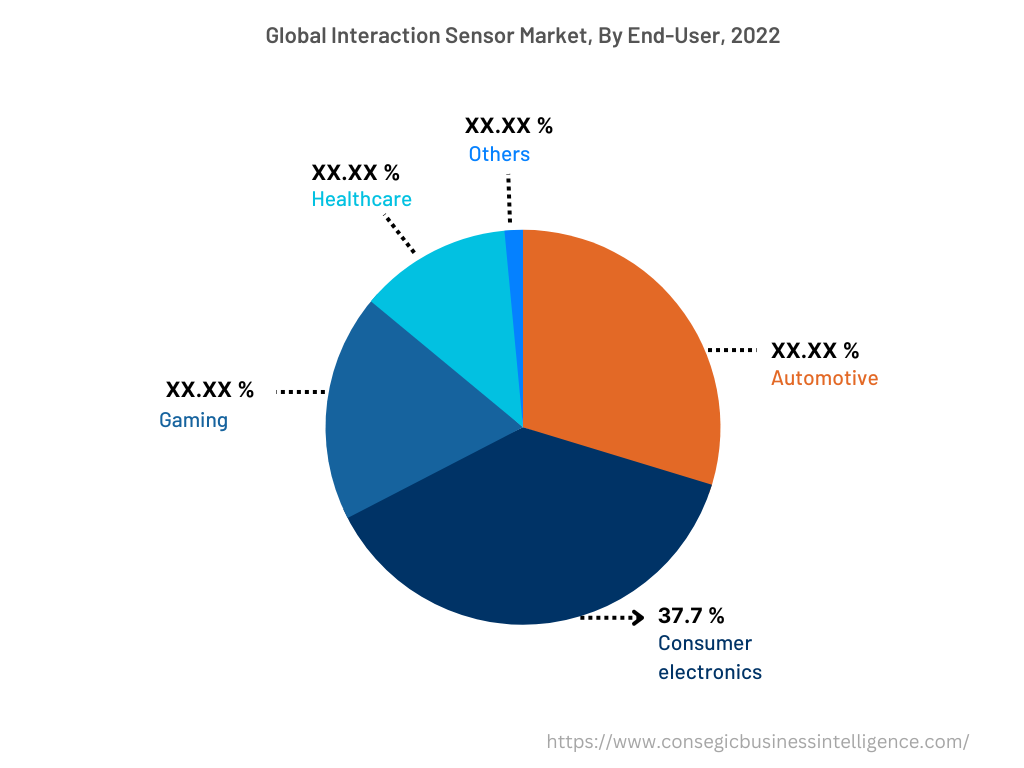
By Region :
The regional segment includes North America, Europe, Asia Pacific, Middle East and Africa, and Latin America.
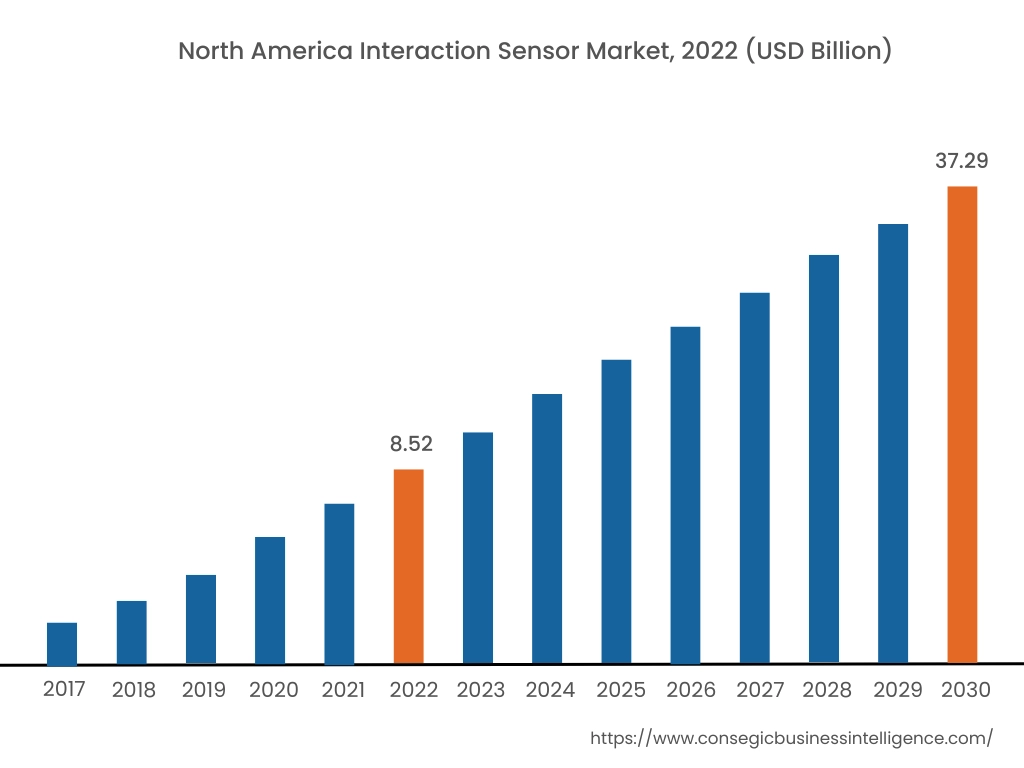
North America accounted for the largest revenue share of USD 8.52 Billion in 2022 and is expected to reach USD 37.29 Billion by 2030, registering a CAGR of 20.6% during the forecast period. In addition, in the region, the U.S. accounted for the maximum revenue share of 64.8% in the same year. The adoption of these sensors in the North American region is mostly driven by its utilization in automotive, consumer electronics, gaming, and other sectors. Moreover, the rising automobile production and increasing utilization of sensors in automobile infotainment system and ADAS for driver assistance are among the significant factors driving the interaction sensor market demand in the region.
For instance, according to the OICA (International Organization of Motor Vehicle Manufacturers), automobile production in North America reached 14,798,146 units in 2022, witnessing a growth of around 10% from 13,467,065 units in 2021. Hence, the growing automotive sector is propelling the deployment of interaction sensor industry, in turn fostering market in the North American region. Additionally, increasing investments in gaming and healthcare sectors are anticipated to promote lucrative growth aspects for the market in North America during the forecast period.
Asia-Pacific is expected to register fastest CAGR of 20.8% during the forecast period. The growing pace of industrialization and development is creating lucrative aspects for the market in the region. Moreover, based on the interaction sensor market analysis, factors including the rise of multiple industries such as consumer electronics, automotive, and others are fostering the market for these sensors and trends in the Asia-Pacific region.
For instance, according to the India Brand Equity Foundation, the consumer electronics sector in India was valued at USD 9.84 billion in 2021, and it is projected to grow at a considerable rate to reach USD 21.18 billion by 2025. Hence, according to the analysis the growing consumer electronics sector is anticipated to drive the utilization of sensors for deployment in smartphones, smartwatches, tablets, and others, thereby, proliferating the market and influencing the interaction sensor market trend in the Asia-Pacific region during the forecast period.
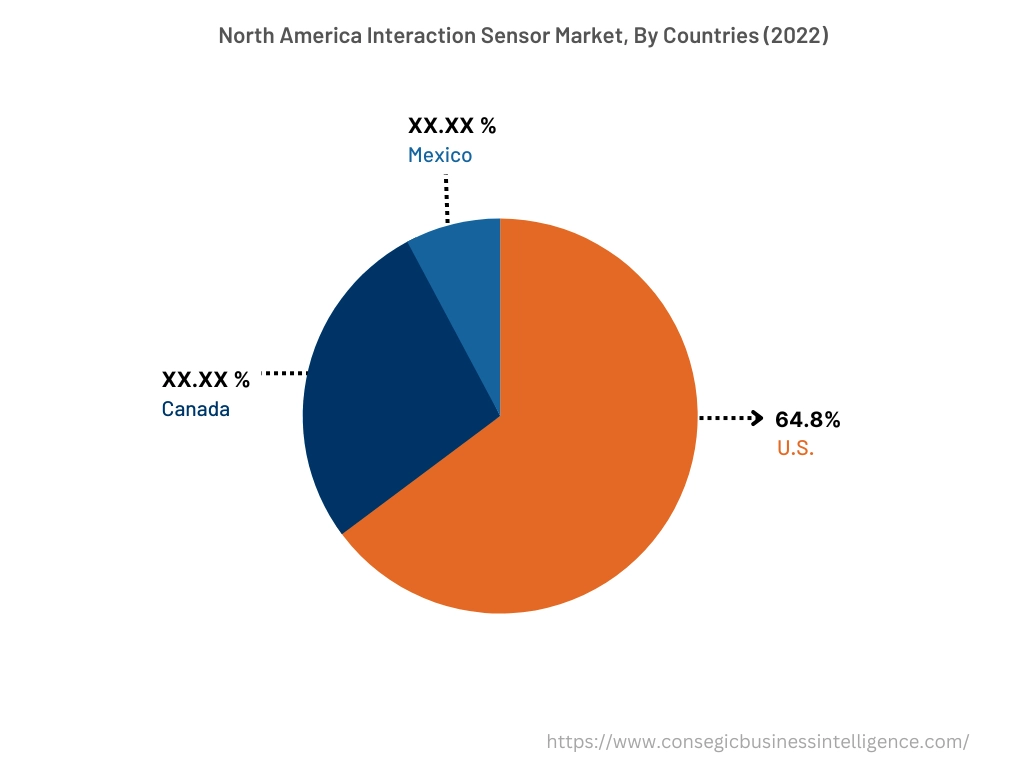
Top Key Players & Market Share Insights :
The interaction sensor market is highly competitive with major players providing these sensor to the national and international markets. Key players are adopting several strategies in research and development (R&D), product innovation, and application launches to hold a strong position in these market. Key players in the these market include-
- Infineon Technologies AG
- Neonode Inc.
- RIKO
- Autonics Corporation
- Keyence Corporation
- KEMET Corporation
- NXP Semiconductors
- OMRON Corporation
- STMicroelectronics
- Delta Electronics Inc.
Recent Industry Developments :
- In January 2020, Neonode Inc., a Sweden-based company specializing in optical interactive sensing technology, expanded its portfolio of touch sensor modules. The touch sensor modules enable new levels of design freedom while allowing for integration in a broader range of applications.
Key Questions Answered in the Report
What is interaction sensor? +
Interaction sensor refers to a device that is capable of capturing minimal movements on a millimetre scale for controlling electronic devices without any physical contact while eliminating the need for designing buttons and knobs into the surface of devices.
What specific segmentation details are covered in the interaction sensor report, and how is the dominating segment impacting the market growth? +
For instance, by sales channel segment has witnessed distributor sales as the dominating segment in the year 2022, owing to the increasing availability of interaction sensors in online distributor sales channels.
What specific segmentation details are covered in the interaction sensor market report, and how is the fastest segment anticipated to impact the market growth? +
For instance, by end-user segment has witnessed automotive as the fastest-growing segment during the forecast period due to the rising adoption of interaction sensors in automotive ADAS and infotainment system among others.
Which region/country is anticipated to witness the highest CAGR during the forecast period, 2023-2030? +
Asia-Pacific is anticipated to register fastest CAGR growth during the forecast period due to rapid pace of industrialization and growth of multiple industries such as consumer electronics, automotive, healthcare, and others.
